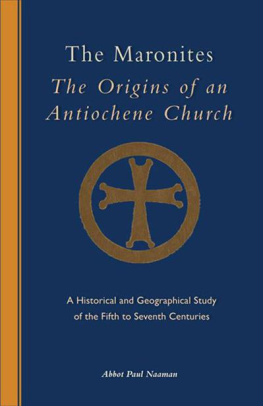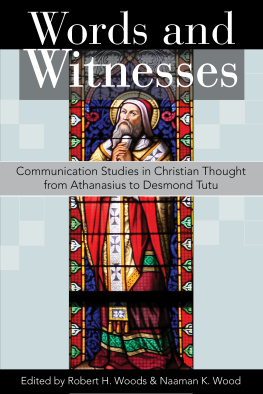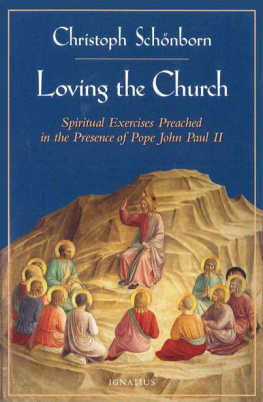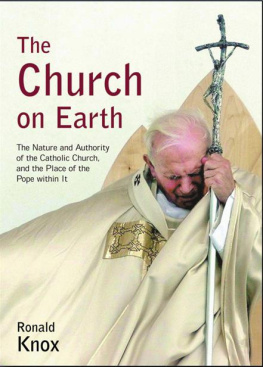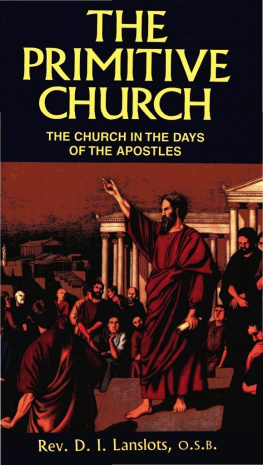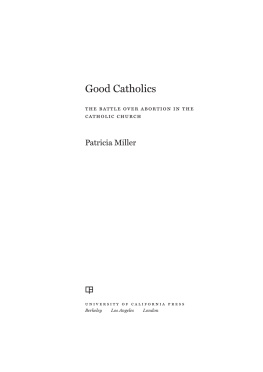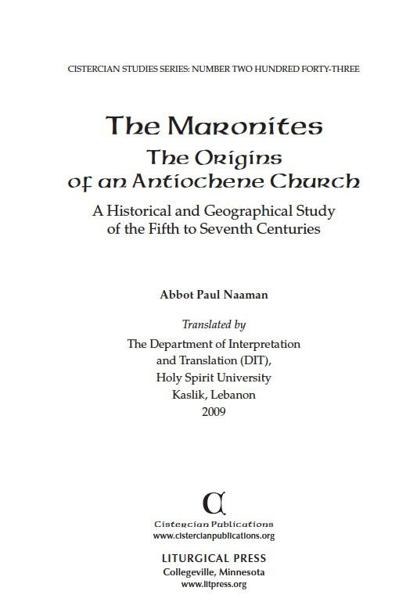The Maronites
Maps adapted from G. Tchalenko, Villages antiques de la syrie du Nord (1953), T. II Pl. XXIII, Pl. XXIV, Pl. XXV. Used with permission.
A Cistercian Publications title published by Liturgical Press
Cistercian Publications
Editorial Offices
Abbey of Gethsemani
3642 Monks Road
Trappist, Kentucky 40051
www.cistercianpublications.org
2011 by Order of Saint Benedict, Collegeville, Minnesota. All rights reserved. No part of this book may be reproduced in any form, by print, microfilm, microfiche, mechanical recording, photocopying, translation, or by any other means, known or yet unknown, for any purpose except brief quotations in reviews, without the previous written permission of Liturgical Press, Saint Johns Abbey, PO Box 7500, Collegeville, Minnesota 56321-7500. Printed in the United States of America.

Library of Congress Cataloging-in-Publication Data
Naaman, Paul, 1932
The Maronites : the origins of an Antiochene church : a historical and geographical study of the fifth to seventh centuries / Paul Naaman; translated by the Department of Interpretation and Translation (DIT), Holy Spirit University, Kaslik, Lebanon.p. cm. (Cistercian studies series; no. 243)Includes bibliographical references and index.ISBN 978-0-87907-243-8 (pbk.) ISBN 978-0-87907-794-5 (e-book)1. MaronitesHistory. 2. Catholic Church. Maronite Patriarchate of Antioch (Syria)History. 3. Catholic ChurchMaronite riteMiddle EastHistory. 4. Middle EastChurch history. I. Title. II. Title: Origins of an Antiochene church.BX182.N33 2011
281'.509021dc222010048732
To my nephews and nieces
To Professor Norman ASMAR
So that they may realize from which mountain
rock they were carved, and from which
fountainhead springs their spiritual wealth
Contents
Foreword
Some attribute early Christianitys worldwide growth to the peace of Constantine in AD 313 and his support of the Church. This assumption, however, does not consider the heroic missionary movement of the early Christians, even in the midst of stiff opposition and martyrdom. In fact, Christianity reached all parts of the Mediterranean basin, as well as India and perhaps China before it became the state religion of the Roman Empire.
Another movement, equally heroic, which flourished after the peace of Constantine and had a stabilizing effect on culture and Church order, was monasticism, the story of countless men and women who gave up everything for the sake of Christ and the Gospel.
Egypt had Saint Anthony, and Europe, Saint Benedict. Anthonys way was solitary, that is, hermits for God alone, Benedicts way communala school for the Lords service. Both pioneers spearheaded spiritual movements which are still vibrant today and have left a lasting mark on Church and society.
The story of Maron, a fifth-century hermit-priest, and the community gathered around him, later called Maronites, is part of this fascinating story of monastic and missionary movements in the Church. In the context of Syrian monasticism, which has always been a combination of both solitary and communal life, the Maronite story is one of a community of Christians who navigated through rough seas of political divisions and ecclesiastical controversies.
Today, the Maronite Church is one of twenty-one Eastern Catholic Churches in communion with the Pope of Rome. Her patriarch resides in Lebanon and forty-three bishops and approximately ten million faithful make up her presence throughout the world.
Abbot Paul Naaman, a Maronite scholar and former superior general of the Order of Lebanese Maronite Monks, wisely places the study of the origins of the Maronite Church squarely in the midst of the history of the Church. This book offers plausible insights into her formation and early development, grounding the Maronite Church in her Catholic, Antiochian, Syriac, and monastic roots.
Abbot Naaman maintains that Theodoret, the bishop of Cyr, himself a monk for seven years and the author of Religious History written in 444, along with the support of the Byzantine emperor, Marcian, founded a monastery from among numerous monks and hermits in order to support the definitions of the Council of Chalcedon (451). The monastery was named after the hermit-priest Maron, who was well known in that region for his sanctity.
According to Naaman, citing Theodorets Religious History, there were two monastic realities in northern Syria: one was coenobitic, that is, monastic communities in the region of Apamaea. The other was eremitical, that is, hermits living in the region of Cyr. Ironically, Saint Maron, a hermit, lived in the region of Cyr; however, after his death, the monastery of Saint Maron was founded in the region of Apamaea. Naaman offers the following explanation.
During the christological controversies of the fifth century, there was a severe lack of discipline among monks and hermits, according to Theodoret. The monastery of Saint Maron, and soon, other Maronite monasteries in the region, provided stability and support to the efforts of Theodoret to arrest the spread of Monophysitism (Christ had only one nature, i.e., a fusion of human and divine) and promote orthodox faith. Naaman notes that this balanced faith and careful discernment served Maronites well in their beginnings, throughout history, and up to the present day.
Naaman, basing his argument on primary and contemporary sources, also recounts the zeal of the monks of Saint Maron in the spread of the Gospel and the effort to defend the Council of Chalcedon, and notes that the head of the monastery of Saint Maron was ordained a bishop in order to assure apostolic succession for the nascent Maronite monastic movement in the midst of threatening influences from other monasteries in the area.
Naamans insightful history, which needs balance from another perspective, namely, the Eastern Orthodox point of view, nonetheless sheds light on the early Maronite monastic and missionary movement. It has been said that the rudder of a ship is small and goes almost unnoticed, yet it would be impossible to direct a ship without it. The case of the beginnings of the Maronite Church in the post-Chalcedonian Middle East is similar.
We are grateful that Abbot Naaman has taken the time and effort to navigate the uncharted waters of the origins of the Maronite Church by means of various manuscripts, and to attempt to discover this tiny rudder of her beginnings. His many years of dedication and commitment to this research have shown that even in the midst of the christological controversies, the history of the Maronite Church can still shed light for Catholics and Orthodox alike.
Although this book is rather complex and rests on certain assumptions, it is, nevertheless, well worth the effort to read. Abbot Naaman himself admits that his hypothesis is in need of completion through further research, and he hopes to inspire the student of history to look deeper.
According to the respected French theologian and orientalist Jean Gribomont, this book is definitively groundbreaking: For the essential point, namely the date and the circumstances of the foundation of the Monastery (of Saint Maron) around which the Maronite nation forms itself, the shadows and controversy are definitely left behind.
This is a treasured work for anyone interested in acquiring a historical perspective of the origins of an Antiochene Church, ecumenical in nature, Chalcedonian in faith, Catholic by communion, ancient yet ever new, which even today combines a missionary and monastic dynamism.
Next page
